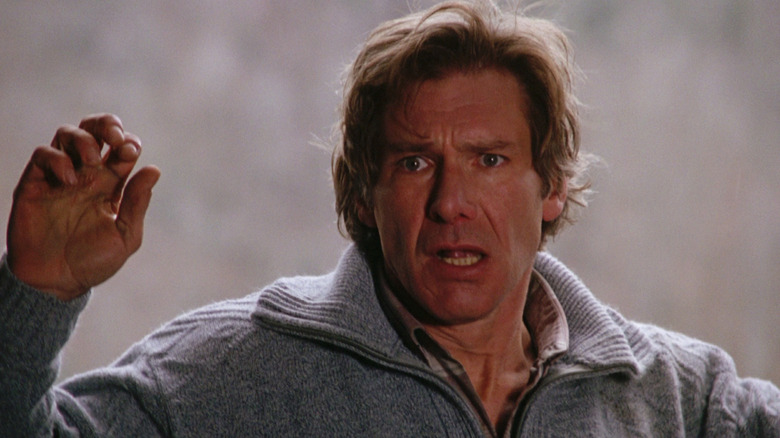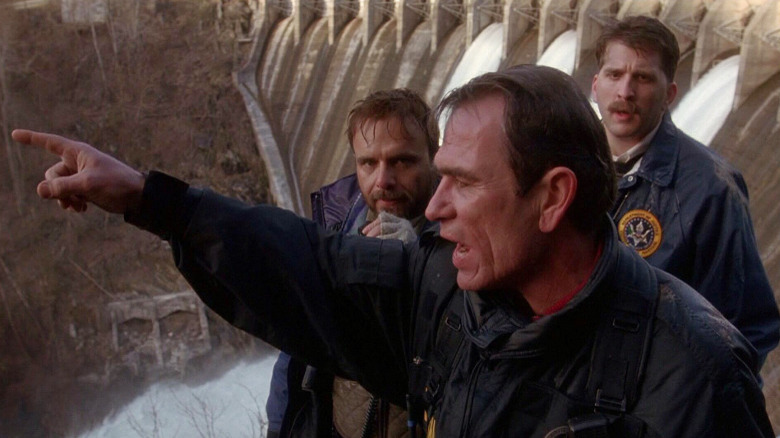How The Fugitive Pulled Off Its Brilliant Dam Jump Scene
There's a long-observed trend where the media landscape becomes inundated with reboots or revivals of films and TV series from 30 years before, often called the 30-year nostalgia cycle. It's why the 1990s was flooded with movies based on '60s TV shows, with some of them becoming big hits in their own right ("The Addams Family," "Mission: Impossible") and others, well, doing the opposite thing. Among the most successful of these films was "The Fugitive," a big screen take on the series of the same name centering on Richard Kimble, a doctor who is wrongfully convicted of murdering his wife and escapes on his way to death row to try and find her real killer: a mysterious man who has a prosthetic arm.
Released in 1993, "The Fugitive" was a critical and box office hit that won an Oscar for Tommy Lee Jones' supporting role as Sam Gerard, the relentless Deputy U.S. Marshal who is absolutely determined to catch Dr. Kimble (Harrison Ford), no matter what it takes. And, boy, does it take him to a dangerous place — quite literally, with Gerard pursuing Kimble on-foot into a storm drain and to the edge of a spillover above a dam, forcing Kimble to risk life-and-limb by flinging himself into the water below to evade capture. It's perhaps the most intense action scene in a movie full of them, not least of all because it was shot on-location at Cheoah Dam in Deals Gap, a mountain pass bordering North Carolina and Tennessee.
Where a scene like that would very likely (and for good reason!) be shot on a studio set were it filmed today, "The Fugitive" director Andrew Davis had Ford actually in place overlooking the edge of the pipe where Kimble makes his death-defying jump. But no need to panic (not too much, at least), Davis and his crew took the necessary precautions to ensure that Ford would feel safe staring death right in the face.
'Fine. Go get a cane pole, catch the fish that ate him'
Ford explained the process behind Kimble's not-so-figurative leap of faith in a special featurette for the 20th anniversary Blu-ray edition of "The Fugitive":
"They had a section of set which was the pipe, and they took it and rigged it on top of the dam, extending over the lip of the dam, so the camera was able to be placed behind me, and the real background was there and they had a safety wire that ran down the lowest part of the sewer pipe and went up my pants to a safety belt underneath, so I felt comfortable enough standing quite close to the edge."
Rather than spending weeks building a set modeled after the real-world tunnel that Gerard chases Kimble into, the "Fugitive" production team came up with an inspired alternative. As detailed in the featurette, they instead drove a flatbed truck onto the top of the dam and built a section on the vehicle where they could pivot the entire top section of the tunnel around. The crew then ran water through it, filmed what they needed with Ford and Jones, let the water out, and casually drove it back to where they had gotten it.
While the effort and resourcefulness it took to execute this scene is notable enough on its own (to say nothing of the terrifying stunt-work required to make it seem like Ford himself actually jumped into the dam), it pays off in the final cut of the film.
"The Fugitive" is one of those action movies in the vein of "Die Hard," where much of the tension and suspense comes from watching its hero confront one major obstacle after another without the benefit of super-powers, or even just great athleticism, at his disposal. It's that tactile element — that is, watching Ford and Jones become visibly winded, soaked wet, and a whole lot more over the course of their dual manhunts — in tandem with the film's tight editing and plotting that led to "The Fugitive" being remembered as an action classic, long after other '90s takes on '60s shows had faded from the world's collective memory.

